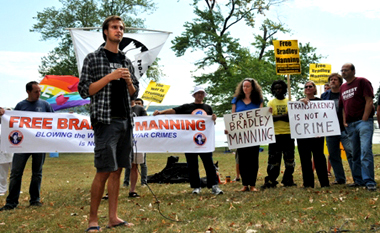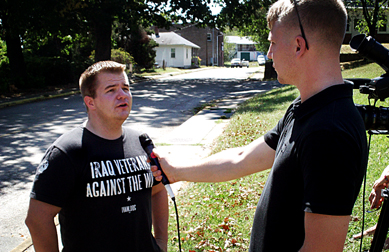They’re 'Slow-Torturing' Bradley Manning Right Under Our Noses
On December 18, David House, an MIT researcher, visited Bradley Manning at the Quantico, Virginia, military prison where he is being held in solitary confinement. Other than Manning’s attorney, House is the rare person allowed to visit him.
House’s report is quite thorough in pointing out instances where the military authorities are lying -- or to use philosopher Harry Frankfurt’s formulation, “bullshitting” -- about how the 23-year-old Army intelligence worker is being treated.
Here’s some of psychologist Dr. Jeffrey Kaye’s comment on House’s report:
"The human nervous system needs a certain amount of sensory and social stimulation to retain normal brain functioning. ... From what can be ascertained, the effects of solitary confinement are having some effects already on Bradley Manning. His concentration and thinking processes appear somewhat slowed. He avoids certain topics. He has little access to humor. His color is pale, and his musculature is starting to look soft and flabby.”
There is, unfortunately, a long and sordid history behind this kind of “slow torture,” and the use of it should be a battleground for all Americans still interested in compassion, fairness and justice.
 Iraq vet Josh Stieber speaks to protesters outside Quantico prison (Mary Davidson/Potomac Local)
Iraq vet Josh Stieber speaks to protesters outside Quantico prison (Mary Davidson/Potomac Local)
(Iraq infantry veteran Josh Stieber, in the photo above, was a member of the ground unit shown cleaning up after the Apache strike released by WikiLeaks as "Collateral Murder" that showed two Reuters videographers being gunned down, plus two kids being wounded.)
In his book A Question Of Torture: CIA Interrogation, From the Cold War to the War On Terror, Alfred McCoy connects decades and billions of dollars of “black” US torture research with the current sophisticated techniques Global War On Terror jailers are using to torture human beings without laying a finger on them.
The key is absolute control -- and time. These are clearly the methods now being employed against Manning, who is accused of leaking the WikiLeaks material. The question is, given Manning's high-profile status, do his jailers at the Quantico, Virginia, military facility have the necessary control and time to really scramble young Manning's mind? And what are they after: his mental breakdown and/or his giving up of larger prey like Julian Assange?
House’s account from his visit with Manning suggests Manning's jailers, within the limitations they have, are doing their best to break Manning psychologically, Their primary limitation is the publicity surrounding the Manning case and the fact he has a strong, and hopefully growing, support network.
Some of the restrictions House reports would be quite absurd if they didn't make such sense as slow torture tactics.
Guards apparently enter Manning's cell and physically prevent him from doing exercises, which he is permitted to do only for one hour a day -- and that amounts to walking around in a circle in leg irons. He is not permitted any personal items in his cell. His clothes are confiscated at night and he must sleep in boxer shorts under a very heavy, scratchy blanket that causes carpet burns on his skin if he moves too much. A light always shines brightly into his cell, and he is checked on periodically all night by guards, who often enter his cell and wake him. This is his life day-in-day-out.
The fact Manning's jailers are compelled to allow people like House into the prison to talk with Manning makes "slow torture" that much more difficult, since absolute control and the exclusion of human contact are the keys to effective slow torture. Strong advocacy and loud public support can be life-savers.

During the mid-2000s, in the case of American citizen Jose Padilla, an entire wing of the South Carolina military brig he was imprisoned in was expensively re-designed for the special requirements ("theater") of his incarceration/interrogation. From the moment of his arrest for planning a "dirty bomb" attack Padilla was a pariah. He reportedly went three years with absolutely no contact from family, friends or lawyers. His only human contact was his interrogators. By the time of his trial for charges unrelated to those he was arrested for he was a walking zombie.
Here's how Alfred McCoy describes the process:
"(S)ensory deprivation has evolved into a total assault on all sense and sensibilities - auditory, visual, tactile, temporal, temperature, survival, sexual, and cultural. Refined through years of practice, the method relies on simple, even banal procedures -- isolation, standing, heat and cold, light and dark, noise and silence -- for a systematic attack on all human senses."
Over decades, CIA research delved into the ways these techniques create "a synergy of physical and psychological trauma whose sum is a hammer-blow to the fundamentals of personal identity."
McCoy quotes Otto Doerr-Zegers, a psychologist who treated torture victims of the regime of Chilean General Augusto Pinochet, where victims suffered "a loss of interest that greatly surpasses anything observed in anxiety disorders." The subject, Doerr-Zegers reported, "does not only react to torture with a tiredness of days, weeks or months, but remains a tired human being, relatively uninterested and unable to concentrate." Doerr-Zegers discovered that "the psychological component of torture becomes a kind of total theater, a constructed unreality of lies and inversion, in a plot that ends inexorably with the victim's self-betrayal and destruction."
Over decades, with their secret, black budget tax resources, the CIA contracted university professors and psychology departments in the US and Canada to analyze and break down the sensory deprivation process. The goal for the CIA was to achieve the psychic destruction Doerr-Zeger spoke about without resorting to the crude and atavistic methods of physical torture. They discovered that parrot’s perches and thumb screws were not needed. The goal was a form of "no touch" psychological ju-jitsu in which the victim's own internal make-up could be manipulated and leveraged so that over time the victim effectively destroyed himself or herself.
"Once the CIA completed its research into no-touch torture," McCoy writes, "application of the method was codified in the curiously named Kubark Counterintelligence Interrogation Manual in 1963. The agency then set about disseminating the new practices worldwide."
McCoy quotes from the Kubark Manual that effective interrogation involves "methods of inducing regression of the personality to whatever earlier and weaker level is required for the dissolution of resistance and the inculcation of dependence." The effort is to disrupt the normal psychic process. "Such confusion can best be effected by attacking the victim's sense of time, by scrambling the biorhythms fundamental to every human's daily life." The goal is the "creation of existential chaos."
They want “to manipulate the subject’s environment, to create unpleasant or intolerable situations, to disrupt patterns of time, space and sensory perception ... to drive him deeper and deeper into himself, until he is no longer able to control his responses in an adult fashion." This last is Kubark thinking from a CIA training manual used in Honduras during the Contra War in the 1980s.
Kubark and this nefarious research is one of America’s dirty little secrets. "The American public has only a vague understanding of the scale of the CIA's massive mind-control project," McCoy writes. "There is a willful blindness, a studied avoidance of this deeply troubling topic."
Since the 1960s when the Kubark Manual appeared and the 1980s when its findings surfaced in places like Central America we've had 9/11 and its reactive Global War On Terror which led to an even wider dissemination of “slow torture” ideas and practices into all sorts of places -- to the point elements of it have been standardized and adapted into the day-to-day practices of prisons all over the United States, most especially in the notorious federal supermax prisons.
Since absolute control of inmate visitation and inmate cultural access is difficult in the United States, thanks to things like the Bill Of Rights, the process has become an imperfect back-and-forth struggle. In the case of Bradley Manning and his high-profile status, that struggle is now on-going. Contact and advocacy from outside is critical. In fact, it may not be excessive to say his sanity and the future integrity of his personal identity are at stake.
Once the fog clears, there are two sides to the Bradley Manning/WikiLeaks story, one legal and one moral. The United States government is playing the legal game because it has a lot to hide under its overwhelming regime of secrecy, which of course is all legal. Evidence suggests they are employing nefarious methods to crush a key voice on the moral side of the dialogue.
Concerned US citizens should do all they can to prevent the government from succeeding.



No comments:
Post a Comment